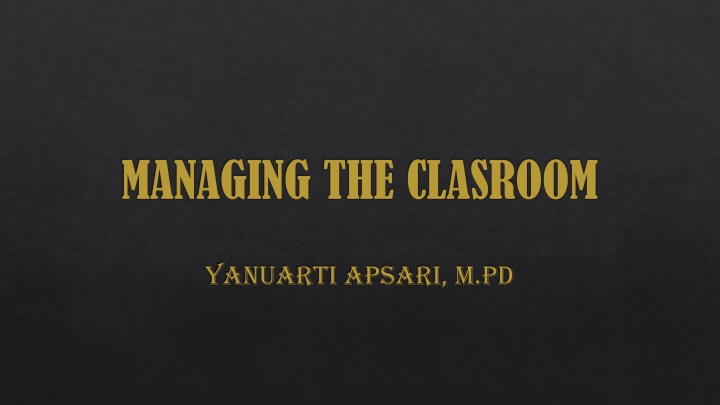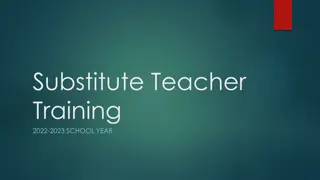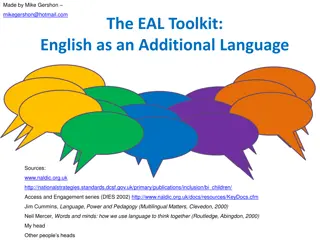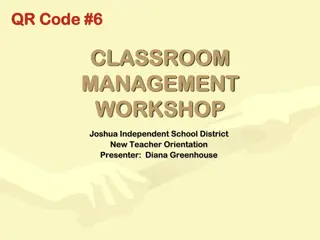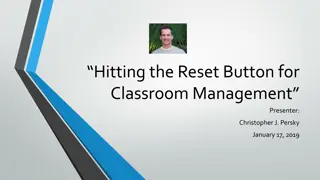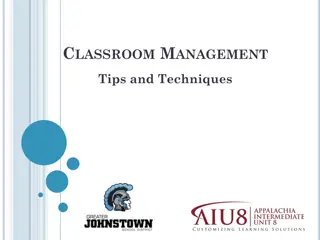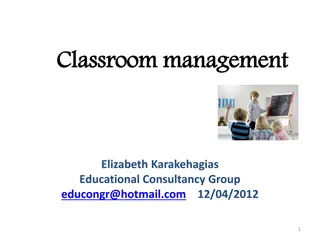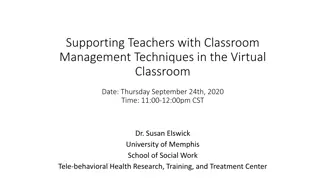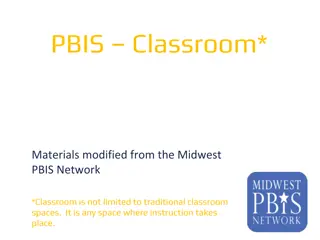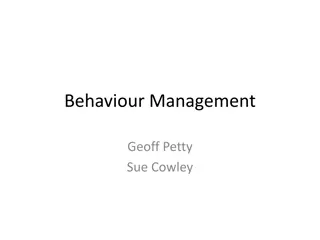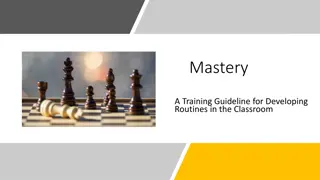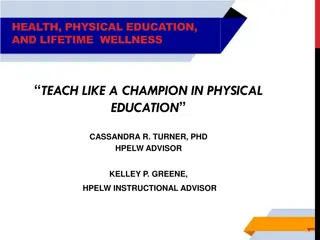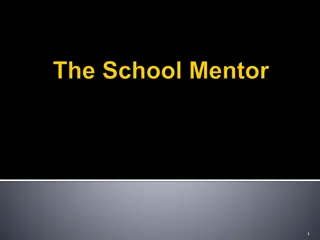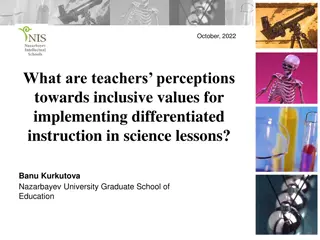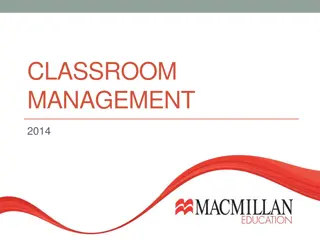Effective Classroom Management Strategies for Teachers
Explore various aspects of classroom management such as teacher positioning, student interaction, organization of space and time, teacher's personality and physical approach, voice usage, and effective communication techniques. Learn about the importance of proximity, appropriacy, movement, awareness, and using voice effectively to create a conducive learning environment. Enhance your teaching skills and student engagement for successful classroom management.
Download Presentation

Please find below an Image/Link to download the presentation.
The content on the website is provided AS IS for your information and personal use only. It may not be sold, licensed, or shared on other websites without obtaining consent from the author.If you encounter any issues during the download, it is possible that the publisher has removed the file from their server.
You are allowed to download the files provided on this website for personal or commercial use, subject to the condition that they are used lawfully. All files are the property of their respective owners.
The content on the website is provided AS IS for your information and personal use only. It may not be sold, licensed, or shared on other websites without obtaining consent from the author.
E N D
Presentation Transcript
MANAGING THE CLASROOM YANUARTI APSARI, M.Pd
CLASSROOM MANAGEMENT Mark each of the statements below YES, NO or MAYBE? The best position for the teacher is standing at the front of the classroom. It s a good idea to point at students if you want them to speak. You should arrange te classroom furniture before the lesson starts. You should be extra polite when asking students to move their chairs, etc (I wonder if you would mind moving....)
5. If students arrive late, you should go back to the beginning of the lesson and explain what they ve missed. 6. Students will understand you better if you speak slowly 7. if you are addressing a student, you should walk up to him/her. 8. visual aids should be as large as possible. 9. using capitals on the board makes it easier to read. 10. give out handouts before you give the instructions.
ASPECTS OF CLASS MANAGEMENT how the classroom space is organised (grouping) How the classroom time is organised Personality (The ability to deal with difficult situation) voice Teacher s physical approcah (The way we talk to students)
The Teacher in The Classroom There are several aspect often marks the difference between successful teaching and less satisfactory lesson. Teacher s personality The way we move and stand. The way we are able to respond to what happens in the class in addition, proximity, appropriacy, movement, awareness also are the important fators that can influence students perception toward the teacher.
1. Proximity: how CLOSE the teachers are to their students 2. Appropricacy: Physical behavior (sitting on the edge of the table) 3. Movement : MOTIONLESS teachers can BORE students. Most successful teachers move around the class to some extent (go to help a pair or group) 4. Awareness : means ASSESSING what students have said and RESPONDING appropriately. We need to be consciousnof what is going on in the students heads.
USING THE VOICE Audibility : teachers need to be audible CLEARLY. Variety : Conservation : just like opera singers, teachers have to TAKE CARE of their VOICE (avoid shouting, being relaced)
TALKING TO STUDENTS Particularly, when you are talking to all students, keep to all the center where everybody can see yu. Dont turn your back on part of the class Watch language grading. Make it appropriate for the level of the class and the activity. ROUGH TUNING is the SIMPLIFICATION of language (grammatical complexity, vocabulary use, voice tone) in order to increse the chances of being understood. Do t talk too much. Keep the use of the language economical.
GIVING INSTRUCTION Keep instructions clear. Give examples where possible rather than explain It is important to CHECK whether the students have understoodwhat they are being asked to do. How can you check that the students have understood? Is there some way of checking understanding?
Look at the following examples of classroom language. What s wrong with them? Can you improve them? 1. Any takers for number 2? 2. does any body want to tell me how they spell their name? 3. if you could all possibly just write down three columns somewhere like this? 4. I want you to get into groups of 3, and I want you to ask each other what you did before. (to practice how long ago.....?) 5. Right. I think you all understand that, because you could have told me if you didn t, so I d like you to do this exercise just so I can see if you really did understand. INSTRUCTION SHOULD BE........
DONT Distribute handouts BEFORE instructions Give long, complicated instructions all AT ONCE Write on or talk to the BOARD while giving instruction DO Show the handout the group and explain how they will use it before giving it to them NUMBER the insructions if you need to give more than one CHECK that students have heard and understood what they have to do
CLASSROOM MANAGEMENT CONSIDERATION 1. Awarenes of where you want the FOCUS OF INTERACTION to be. Teacher to Class (T-C) Teacher to Student (T-S) Student to Student (S-S), pairs Individually Groups
OVERUSE OF TTT (Teacher Talking Time) is inappropriate (the more a a teacher talks, the less chance that the students have to practice their speaking) A good teacher maximizes STT and minimalis TTT (it is students who need PRACTICE not the teacher)
DIFFERENT SEATING ARRANGEMENTS 1. orderly rows 2. Circles 3. horseshoes 4. Separate table 5. solo
DIFFERENT STUDENT GROUPINGS 1. whole class 2 group work and pair work 3. solo work 4.Class to class
DESCRIBING LEARNING AND TEACHING Learning VS Acquisition According to Krashen (1980) teachers should emphasize on acquistion than learning by providing the right language exposure (comprehensible input). The students will acquire the language just as children do. Requirement for acquisition: Enormous amount to language EXPOSURE ROUGH TUNING (simplify the language, don t use complex sentence or technical vocabulary). EXAGERATE the intonation. It gives motivation to use the language and opportunities to use the language
DIFFERENT TIMES, DIFFERENT METHODS Grammar Translation Method (1780) It teaches people about the language but doesn t really help them to communicate effectively with it
2. Audio- Lingualism (1940) Learning is the result of habit formation -extensive use of DRILLING (choral and individual repetition). The students produced the same grammatical pattern but prompted to use different words within the pattern, e.Q would you like to go to the movie with me tonight? (Movie/Restaurant)
3. PPP (Presentation, Production, Practice) Presentation: present the context and the situation for the language (describing someone s holiday plan). Explains and demonstrates the meaning and form of the new language (Going to) Practice: the students practise making the sentences with going to (controlled practice). This stage involves drilling Production : they talk more freely about themselves or other people
4. Communicative Language Teaching (1970) Language is not just pattern of grammar with vocabulary item slotted in, but also involves language function, it is about how to use it The focus of CLT is on the students communicating real messages
5. Task Based Learning The emphasis is on the task rather than the language such as the students perform real-life tasks (making presentation) The syllabus is a list of tasks and activities, not a list of language. The steps in applying TBL: 1) Pre task (students are introduced to the topic and told what the task will be). 2) Task cycle (plan the task, gathering the language and the information to do the task, then produce the written or oral task). 3) final language phase (students analyze the language they use for the task, making improvement and practising the language that need to be developed)
ELEMENTS FOR SUCCESSFUL LANGUAGE LEARNING (ESA) ENGAGE Materials and activities in this phase involves games, music, discussion, stimulating pictures, asking the students t make prediction and relating teashing material to their own lives. STUDY The students are asked to focus on the construction of the language (study the element of grammar). ACTIVATE This covers exercises and activities designed to get students using the language.
ESA LESSON SEQUENCES 1. Straight arrow: Engage teacher gets the class interested and enagaged. Then, they study something. Then, they try to activate it by putting it into production. Study Activate. First, the 2. Boomerang : Engage Activate Study Activate 3. Patchwork : Engage Activate Study Activate activate engage study
No 1 Problem Solution Students feel inhibited Use group work. Tell them why speaking activities are so important Pre- teach necessary vocabulary, structures, communication strategies, functions. If your students do not know a lot about the topic, work out how you can fill the gaps . Providing a medium: a picture Base the activity on easy language. Use group and pair work to generate ideas Note down errors during the activity and select the significant errors for a correction at the end. 2 Students are unable to express themselves Students have no interest in topic, or lack of motivation Students have nothing to say Students make many errors 3 4 5
